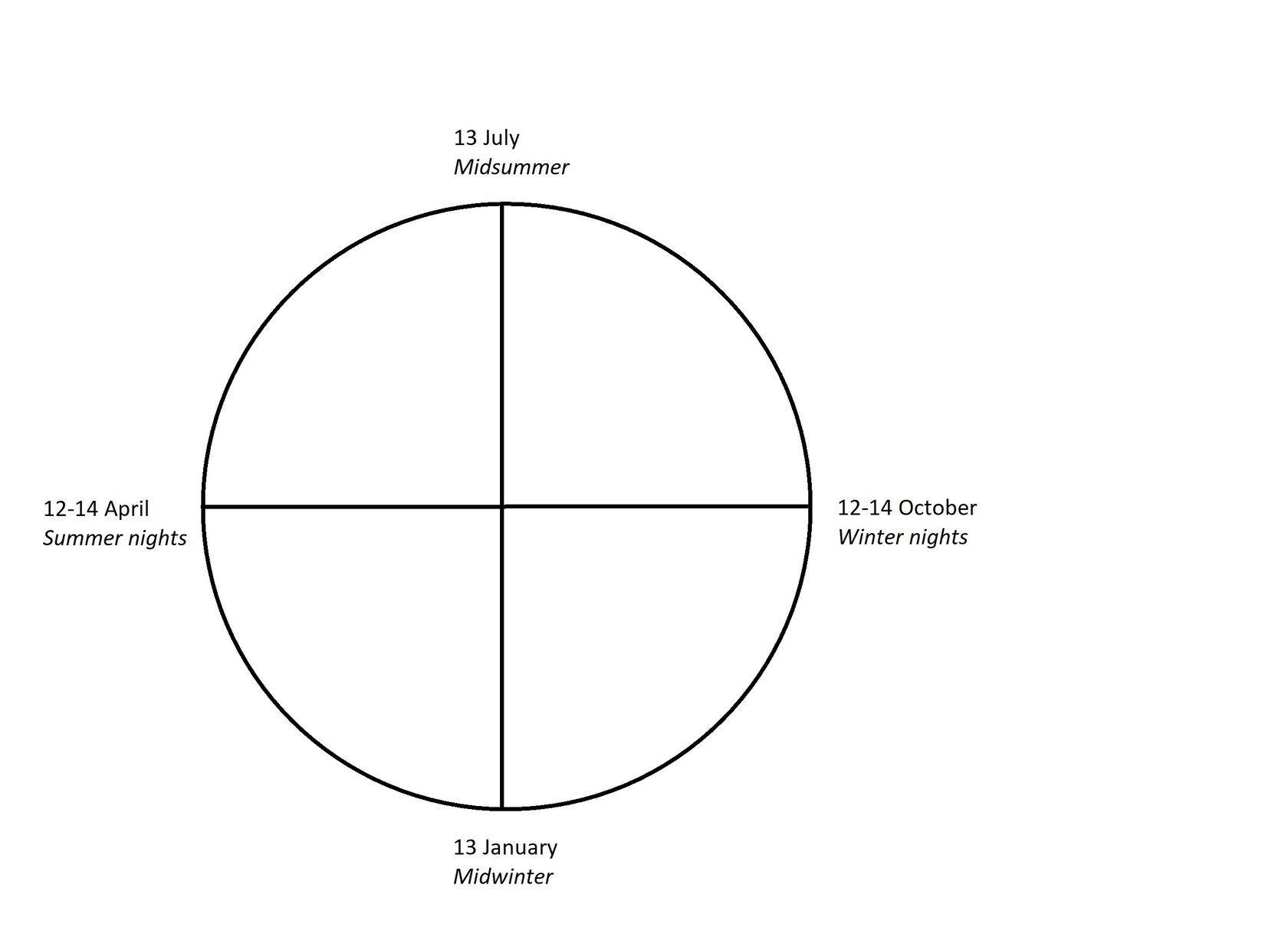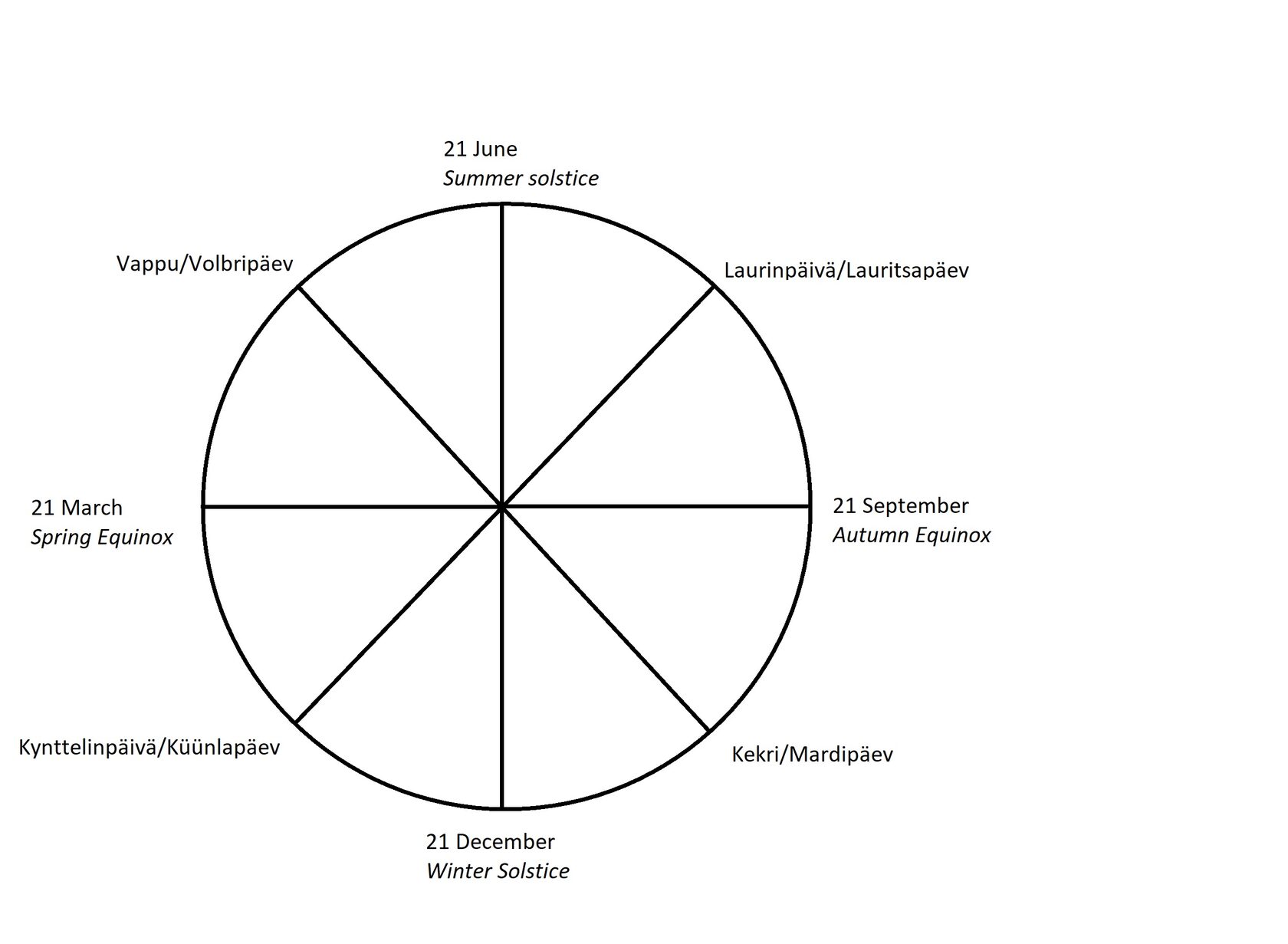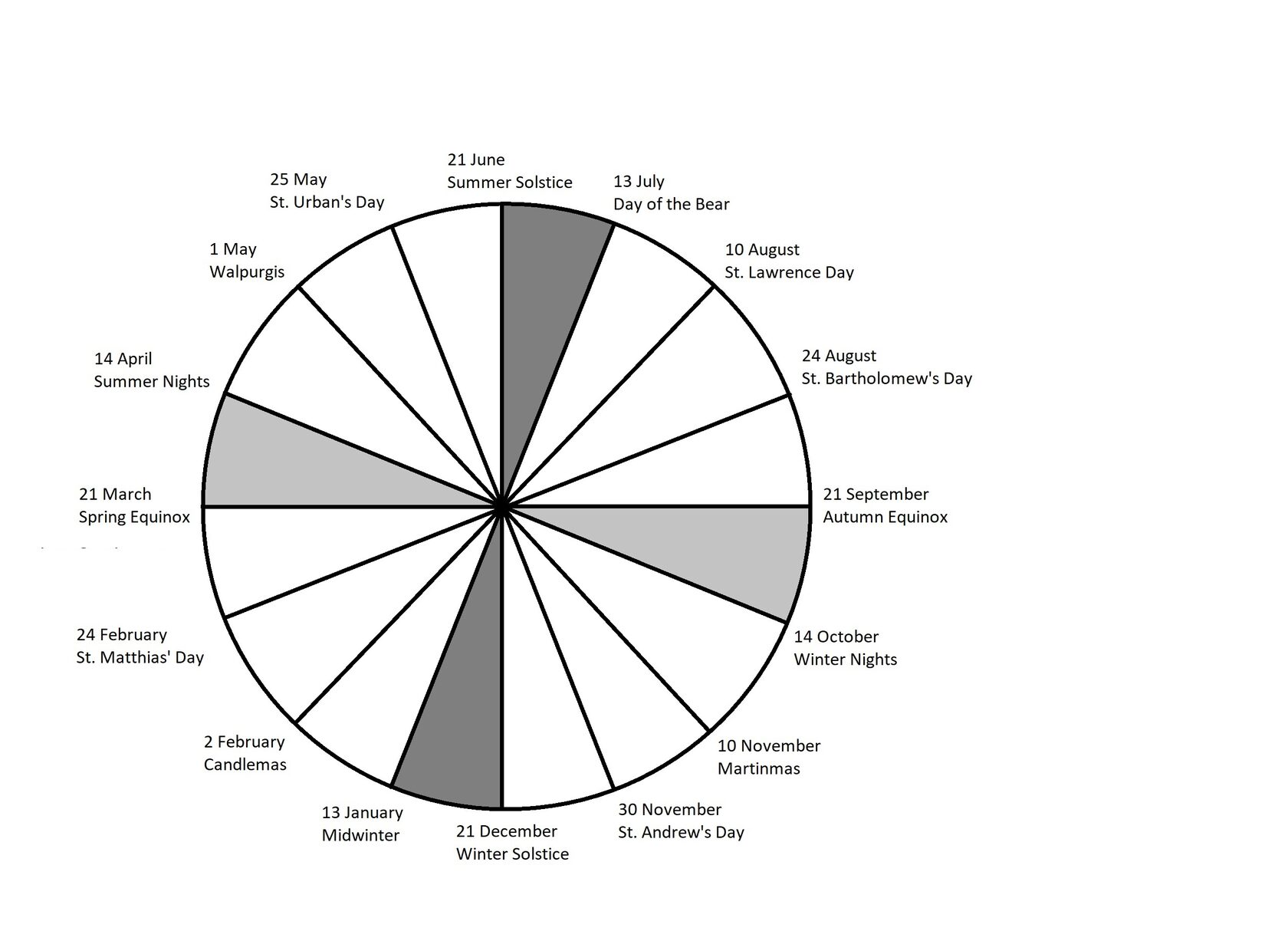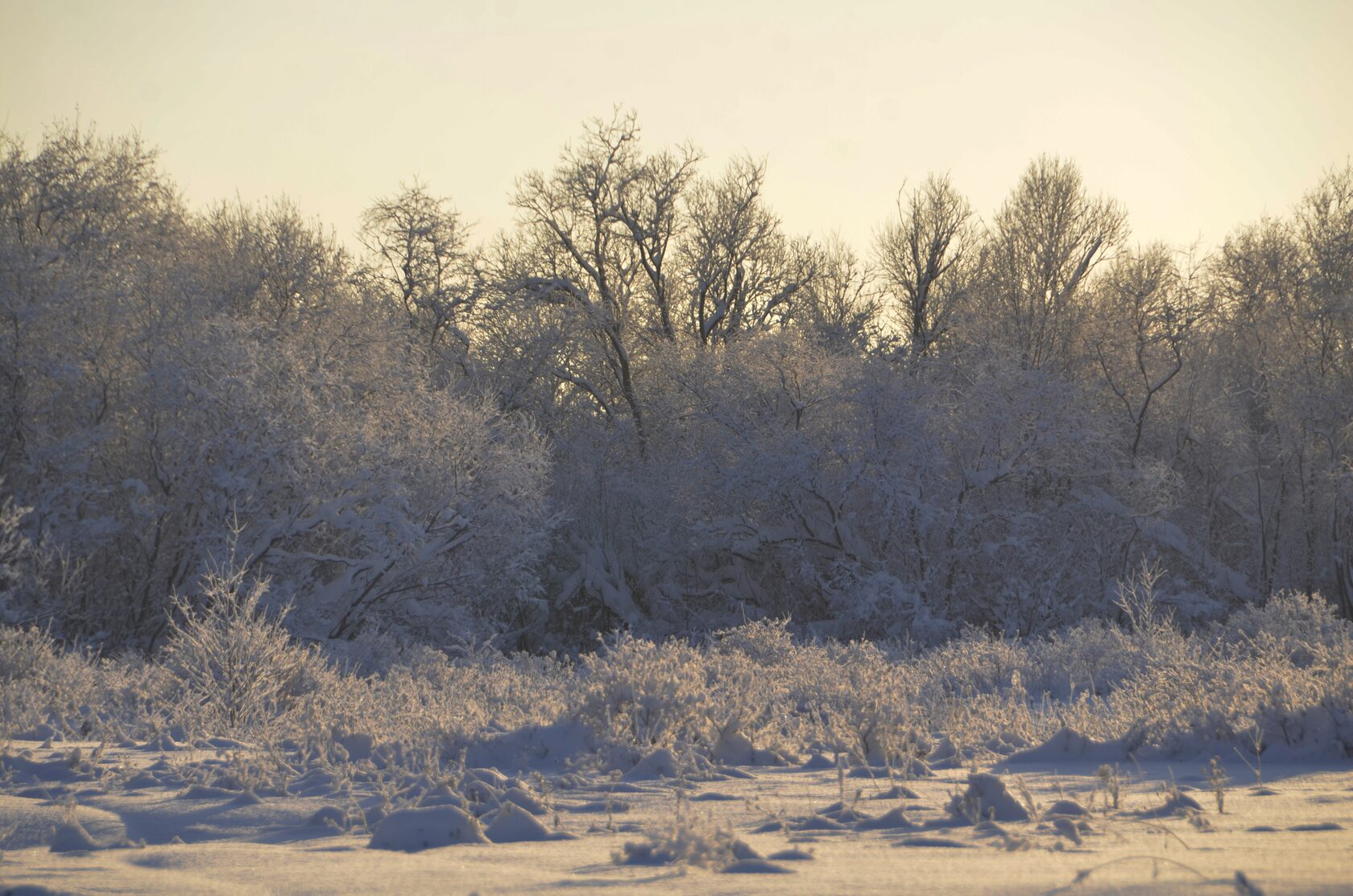What follows is the Via Electri's thoughts on the celebration of the solstices and equinoxes (called hereafter the solar days) from a Finnic perspective. When examining the ritual and mythological aspects of the solar days, a few levels coexist that need to be taken into account.
Firstly, the Finnic peoples are European, but some of their origins lie not only in the North, but also in the East, the Finnic languages being ultimately of Uralic, and therefore Siberian origin. This is reflected not only in the language, but also the traditional culture and mythology of the Finnic peoples that shows the heritage of the two traditions. Such an example of Uralic mythology would be the mythology related to the bear. We demonstrate that this mythology is connected also to Indo-European mythologies related to the seasonal changes caused and symbolised by the movement of the celestial bodies.
Secondly, the folk calendars of the Finnic peoples are greatly influenced by the Christian church for centuries, which has led to most folklorists and anthropologists to refrain from reconstructing a pre-Christian astronomical system. However, we aim to show that such a work can be done, and has indeed been done by a few scholars. This enables us to compare the Finnic calendar with both Uralic calendars of eastern kindred nations that have preserved their Pagan traditions more intact, as well as with European Pagan calendars that follow the same astronomical system.
The Celestial Bear

The example mentioned in the introduction, the mythology related to the bear, is important not only as an example of Uralic (and North Eurasian) mythology, but also in its astronomical significance. Some of the most intact descriptions of common Eurasian bear funerals are preserved not only among the Siberian relatives of Finnics, that is, among the Khanty and Mansi peoples, but also among the Finns (called karhunpeijaiset). In fact, the ritual funeral involves an important mythological history for the origin of the bear: in both the Finnish and Siberian traditions, the bear is born in the constellation of the Big Dipper (Ursa Major, ”the Great Bear”) and lowered in a golden-silvery cot under a pine tree, and nurtured by the Goddess of the Pine Tree (Finnish Hongatar). When the bear is slain, his soul is returned to the heavens by hanging his skull on the branch of a pine tree, enabling the return of the soul once more on earth.
The bear is the Son of the Sky God and he is the Ruler of the Forest, of heavenly origin. Spells and magic are performed when letting the cattle into the forest in spring to protect against his wrath and bear skull islands sometimes have the name ”Forefather-island”. His motions and actions designate the turning of the seasons: at Autumn Equinox, he starts to look for a den for winter; during 13 January (Finnish talvennapa 'centre of winter', Estonian taliharjapäev 'winter's crest day'), he rolls onto his other side, thus halving the winter; at Spring Equinox he wakes up from his sleep; and on 13 July he is remembered when the cattle is in his kingdom, the forest. The worldly bear is, therefore, a sign of heavenly forces that appear in the celestial spheres.
Midwinter
In traditional Finnic folklore, the solar days have been heavily influenced by Christian culture. The two most important celebrations are surely Christmas (Finnish: joulu, Estonian: jõulud, 24 December) and Midsummer (Finnish: juhannus, Estonian: jaanipäev, traditionally 24 June). While these days are centred around Christian interpretations of the days, the traditions related to them are based entirely on the pre-Christian religion. One could say that Midsummer has preserved the original function and significance the best, and it is still recognised as a fertility rite in general knowledge. Its counterpart, Christmas, is, however, a relatively late cultural celebration, having spread from the west and become culturally significant from the 18th century onwards. Before this, other dates were celebrated as either the end of the year or midwinter. More specifically, the current Christmas celebration itself is an adaptation of kekri traditions.
Kekri (dialectally also keyri, köyri, köyry) is a shortening of the former name kekrijuhla, that is a compound of kekri- (from kekrä) and juhla 'festival'. The first word is of Aryan origin and is cognate with Sanskrit चक्र chakra 'wheel (of a carriage, of the Sun's Chariot, of Time); cirlce; cycle (of the seasons), etc.'. The word juhla is an older loanword of the Germanic word *jehwlą 'festivity; Yule', that was later adapted as joulu, from Scandinavian (cf. Old Norse hjúl). Kekri was celebrated as the end of the agricultural year and beginning of winter, November 1 at the latest. At the latest, because it was a mobile festival, depending on when the work of the season was finished. In a communal context, kekri would last from when the first house was ready and hosted a communal celebration to when the last house had likewise finished. The festival was followed by a 12-day liminal time called jakoaika ('dividing time'), which evened out the difference between the lunar and solar calendars.
What of the time of Midwinter then? The example of talvennapa/taliharjapäev above points to an anomaly in time-keeping, at least from a superficial point of view. If we are to consider the yearly cycle to have centred around the bear, then indeed the solar days are less significant. The name of the January celebration in itself reveals that the middle of winter was not based on the solar movement. However, there is folkloric evidence pointing to a connection between the two, namely, the traditional length of Yuletide. From a solar perspective, the period that began with the Winter Solstice would last for twelve days, until the Epiphany. In Finnish tradition, this day was followed by St. Canute's Day, 7 January. However, this was also called 'the new Canute', because an older tradition celebrated the end of the Christmas season on 13 January, which was called 'the old Canute'. This date was also celebrated as the end of the Christmas season in West Estonia. Thus, we see a connection between the solar and the ursine calendars. This connection between the dates is supported by evidence form other Uralic calendars (more on that later), and it is also apparent when investigating the Midsummer celebration.
Midsummer
The polar opposite of winter is summer, similarly to night and day. Therefore, when looking at the calendaric opposite to talvennapa/taliharjapäev, six months ahead is not the solar Midsummer, but 13 July. Tradition related to this day in the Finnic context has been preserved the best in Estonia, where it is called karusepäev, 'the day of the bear'. It has been the traditional starting point of the hay harvesting season and in this function is is preserved also in Finnish folk calendars, where the day is named after Saint Margaret the Virgin (although the feast day of the saint elsewhere in Christendom is on 20 July).
Then again, Finnish folklore calls the period before juhannus (24 June) pikkukesä ('little summer'), the period after it isokesä ('large summer'). Here we see a division based on the solar Midsummer, in line with the common European understanding of the seasons. Perhaps this is a later and indirect influence of the Christian period, when solar days began to be emphasised in the liturgy and medieval ritual calendars through the Christian proxies of the cardinal points?
Such a possibility is discussed by the Finnish folklorist Kustaa Vilkuna in his work ”Vuotuinen ajantieto”. Vilkuna argues that the pre-Christian Finnish calendar was based not on the solar year, but the temperature changes. Vilkuna also argues that such a calendar was more essential to northern peoples, because of the greater fluctuation of the sun during its yearly cycle. The northern peoples didn't need the sun to tell the time, when the moon was visible more often. Also, the in such a system the observable changes in nature were felt through changes in the temperature, again being more important to northern cattle herders and farmers than the amount of daylight. Vilkuna points out that the lowest and highest average temperatures in Finland do indeed coincide with 13 January and 13 July, respectively. Nonetheless, we believe this to be but a part of the truth, as will be shown below.
Summer and Winter Nights
The ”midnight of the year” in Finnic folklore has thus been determined to be 13 January. Its polar opposite, the ”noon of the year”, that is, 13 July, is preserved in Estonian folklore and so would require further evidence to corroborate this division of time. Drawing on the analogy of the 24-hour period, it would be necessary to know the ”morning” and ”evening” of the year.
In fact, such evidence does exist directly in Finnish folklore. More precisely, the year is divided into summer and winter halves, the beginnings of which are, respectively, 14 April and 14 October. These days are preceded by three nights that are called, again respectively, ”summer nights” and ”winter nights”. Even in Estonian folklore, there are specific names for these days: 14 April is called künnipäev 'ploughing day', and 14 October is called kolletamispäev 'yellowing day'. The vernal day is largely symbolic, because it may be that the ground is still frozen in Estonia and in turn the autumnal day refers to the leaves in trees turning yellow, although at this point they may have already fallen, or nowadays may not have turned yellow yet. Nonetheless, these are old names and as such refer to a division of time that is in line with the two days of the bear in winter and summer.
Two time-keeping systems?
Thus, we have discovered a division of the year that is centred around the bear: the lowest and highest points of the year are directly connected to him, and the cardinal points in between are the beginnings of the summer and winter halves. This is a fairly basic division of time and according to many Estonian and Finnish folklorists has been the primary one during prehistorical times. The division is illustrated below in figure 1.

Figure 1. The Year of the Bear.
However, we must still return to the solar days and question their recent origin that was mentioned in connection with Midwinter. Namely, that even though Christmas became more celebrated acros Finland from the 18th century onwards, its name (Finnish: joulu, Estonian: jõulud) is Scandinavian in origin and thus precedes Christianisation by at least a few centuries, even though most of the current ways of celebrating Christmas come from adjacent festivals.
Then again, the reverse is true for Midsummer, in that only the name of the celebration (Finnish: juhannus, Estonian: jaanipäev) is of Christian origin (from Johannes/Jaani, the corresponding translations of John the Baptist), whereas all the traditions related to the given day are clearly of pre-Christian origin: bonfire, staying up all night, rolling naked in the field for fertility, fortune telling with flowers/blade under the pillow, looking for the flowering fern, etc. Nothing in the tradition points to a Christian interpretation, and therefore the traditions must be millennia old. This leads to the conclusion that we must consider also the solar division of the year to be ancient in origin.
Coming back to the solar calendar, we are nowadays probably familiar with the ”Pagan Wheel of the Year”, in which the solar year is divided into eight equally long parts: the four cardinal points of the sun and the midpoints between them. The midpoints are in February, May, August and November, and they are especially important in the Celtic tradition, the midpoints being named in Irish Gaelic, respectively, Imbolc, Beltane, Lugnasadh and Samhain. Although this division has been criticised by some as modern and artificial, it is still astronomically valid, rendering the critique irrelevant. In addition, astronomers studying Stonehenge have noted that such a division was indeed known in Europe already during Megalithic times. These midpoints are present also in Finnic traditions: the February celebration is known as kynttelinpäivä/küünlapäev ('Candlemas') on 2 February; the May celebration is known as vappu/volbripäev (coming from the German Walpurgisnacht) on 1 May; the Autumn celebration is known as laurinpäivä/lauritsapäev ('St. Lawrence's Day') on 10 August; and the November celebration is either kekri (mentioned above) or martinpäivä/mardipäev ('St. Martin's Day') on 10 November.
The exact astronomical dates for the midpoints, according to G. S. Hawkins, should be around 4 February, 6 May, 8 August and 8 November. However, the Irish celebrations mentioned above are celebrated on the first day of the month, which is why kekri is mentioned in connection to the November date. As we can see from the other dates, there has been significant Christian influence on the observance of these astronomical days. This, however, should not be an argument against the dates of the midpoints, since only by looking at the Christian celebrations of the four cardinal points of the solar year, do we see an attempt to redirect attention from astronomy to ideology: Christmas (25 December) in place of Winter Solstice; the Annunciation (25 March) in place of the Spring Equinox; Midsummer named after John the Baptist and celebrated in 24 June in place of the Summer Solstice; and Michaelmas (29 September) in place of the Autumn Equinox. Considering that the cardinal points themselves have been faded out from general knowledge in such a way, it is no wonder to find a similar attempt with the midpoint celebrations.
Thus, we arrive at a solar calendar as illustrated on figure 2 below, with midpoints shown with the Finnish and Estonian names of the approximate celebrations mentioned above.

Figure 2. The Year of the Sun.
Towards a complete astronomical calendar
At first glance, these two years – of the Bear and of the Sun – would seem to be parallel yet different systems. However, the cardinal points of the Year of the Bear in fact fit within the solar year. This is due to seasonal lag, in which the marine climate delays the effects of the solar cardinal points in the Northern Hemisphere by about three weeks. In addition, the cardinal points of the two systems are within astronomical accuracy from each other, and indeed calculations on the Stonehenge have produced a 16-point division of the year that would include both the solar and ursine dates. This has allowed such authors as Tõnu Ülemaante to calculate a 16-point astronomical calendar based on the Estonian folk calendar that incorporates both the Year of the Bear and the Year of the Sun, with similarly midpoints in the former as they are known in the latter. This astronomical year is reproduced below in figure 3.

Figure 3. The Finnic astronomical year.
A few points are worth mentioning in relation to this calendar. As the author himself admits, the secondary midpoints (of the Year of the Bear) are added ”slightly forcefully”, and especially St. Urban's and St. Bartholomew's days are somewhat afar from the correct astronomical dates. The exact astronomical dates for the midpoints would be: 25 February, 29 May, 31 August, 29 November. It could be added that for the November date, there is actually another date that has strong traditions connected to it: 25 November, St. Catherine's Day (Finnish: kaisanpäivä, Estonian: kadripäev). Since the spring and summer midpoints have shifted towards the Christian saints' feast days, it is possible that the same has happened with the autumn midpoint.
However, that is not to say that the system is in essence flawed. As is known from the history of the Christian church attempting to redirect attention from pre-Christian festivals (see also above on the solar year), it is not far-fetched to consider any of the midpoint dates to be wrong in themselves. Also, many dates in folk calendars in both Estonia and Finland had merely the significance of predicting the weather and/or signalling the beginning of certain seasonal work (fishing, hunting, etc.), and so it is not unlikely that some of the dates on this astronomical calendar could also have had such a role. In addition, Finnic folk calendars would include mnemonic tools such as week counts to keep track of time. The key weeks would be named after the saint whose feast day was on the week (for example, ”from Christmas six to Candlemas, from Candlemas three to Matthias, etc.”). Such as system could also have been in use at least in part already in pre-Christian times.
The dark grey sections represent the time between the solstices and the ursine cardinal points of winter and summer. As mentioned above, the connection between these two points is suggested not only in Finnic folklore itself, but also supported by Uralic evidence. That is to say, that among the Udmurts, a Permic people who live on the European side of the Ural mountains and who have preserved unbroken Pagan traditions, the periods in question are both named after the term vožo 'sacred liminal time': vožodyr 'vožo time' for the winter period, invožodyr 'sky vožo time' for the summer time. Both of the periods are connected with water spirits that are active during these times, at night during winter and at noon during summer. There are many prohibitions related to these spirits and these times and writing about the Udmurt calendar would require an article of its own, but for the sake of our focus on the Uralic solar days, it is most important to note here that the periods in question last for a few weeks. In fact, the end of the winter period is marked by sending the water spirits downstream to the north (the direction of the deceased in Uralic mythology) around mid-January depending on the local tradition, whereas the summer period and its prohibitions is accompanied by a ritual on 13 July. Therefore, these are ritually important times which last for many weeks, during which everyday rules of life do not apply. This is also in contrast to the equinoxes, which are celebrated for the one day these astronomical events occur, making them different in character to the solstices. It becomes apparent from both the Finnic and the Permic traditions that the solstices have preserved their importance to modern times, which is why these liminal times are marked in the calendar above.
The light grey sections represent a time that is best preserved in the autumnal period, that is, the time of the spirits (Estonian: hingedeaeg). The traditional information on this period differs a lot and depends on the local traditions: the duration of the time is said to be between one and six weeks; and the starting point is said to be Michaelmas, but mostly it is said to be before St. Martin's Day or Christmas. This time is called jaguaeg ('dividing time') on the north coast of Estonia and is thus related to the jakoaika mentioned in connection to kekri above. Yet another commonality of this time is the masked spirits going through villages at this time, whether it be kekri, St. Martin's Day, St. Catherine's Day, Christmas or St. Canute's Day. These represent the spirits of unrelated ancestors, who start walking among humans on specific days during this time, when the border between this world and the otherworld is hazy and thin.
No matter the difference of and multitude in traditions, it can be said that the entire time between the end of summer and midwinter is a time that is preserved for the the powers of the north, that is, the unknown forces of chaos, disease, cold and death. The reason we consider the Autumn Equinox to mark this period is because of tradition related to this day. Most of the tradition is connected with Michaelmas, for reasons we have explicited above, but what tradition has been preserved in connection with the Autumn Equinox is the same as that of Michaelmas. That is, cattle had to be brought inside, the chosen animals slaughtered and the fields had to be harvested by this date. Also, this is the time when the bear and the snakes started looking for a place for winter hibernation, reflecting yet again the connection with the sun and nature.
The corresponding time in spring is also preserved in tradition: the tradition around the Annunciation is that women offered a red drink to men in South Estonia, be it juice or spirits. This was reflected in turn during the Autumn Equinox, when men offered a red drink to women. Such parallels between spring and autumn days abound. For example, the days of St. Matthias and St. Matthew are both called matti in Finnish, but the first is called, among others, talvi-matti 'Winter-Matti', the second syys-matti 'Autumn-Matti'. In later tradition, these have become the dates when, respectively, the snake awakes from and goes to hibernation. There are many more examples that can be returned to in later writings, but suffice to say that the spring and autumn festivals form a clear pair of sacred times, which is why they are highlighted in the Finnic calendar.
This article is an overview of the different elements that make up the Finnic astronomical calendar that is preserved in Finnic folklore. It must be acknowledged that this overview is lacking an element that has been much more important for the northern peoples, that is, the lunar cycle. It is a large topic in itself, worthy of an article of its own. Nevertheless, the existence of a lunisolar calendar among the northern peoples is dependent not only on the moon, but also the sun, and this article is a starting point to rediscovering that ancient time-keeping. We at Via Electri work to continue the traditions that have enabled the preservation of such an important mythological, ritual and astronomical knowledge. One way of forwarding these traditions is by following the ritual year, the Finnic version of which is introduced in this article. With this article, we wish everyone a blessed Winter Solstice!

